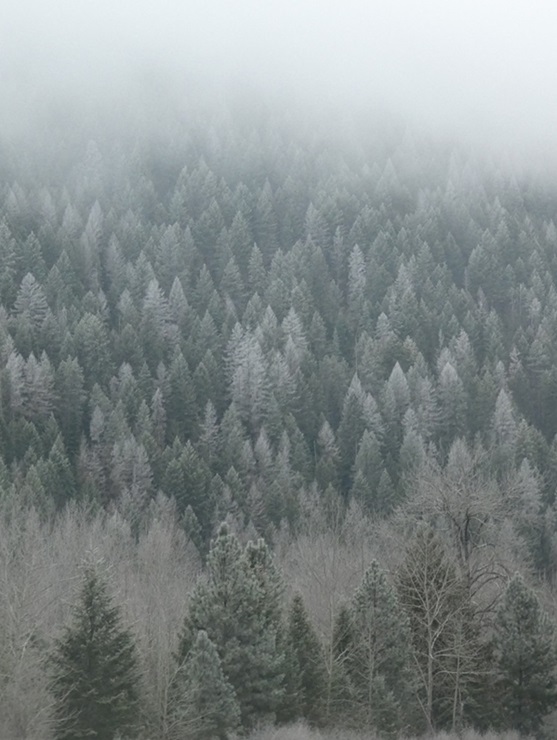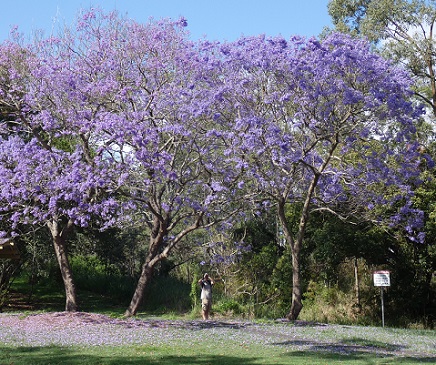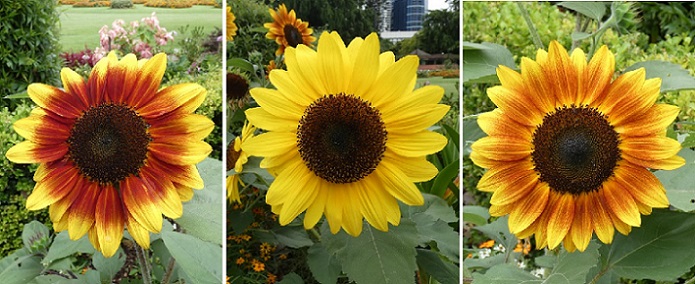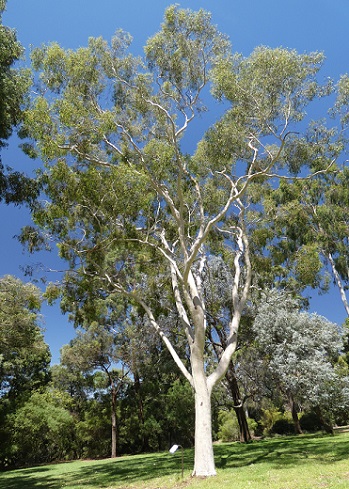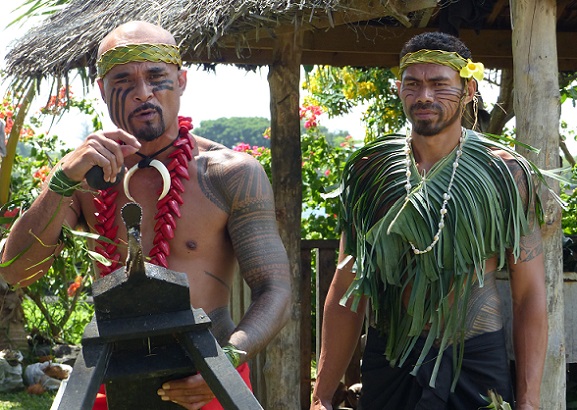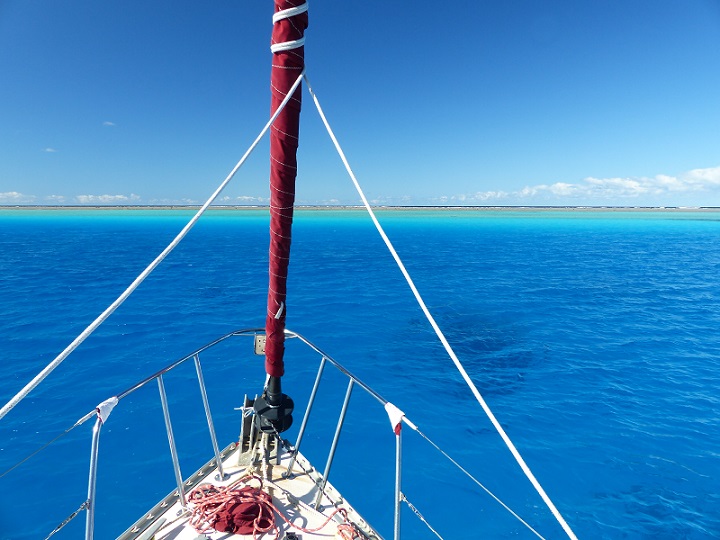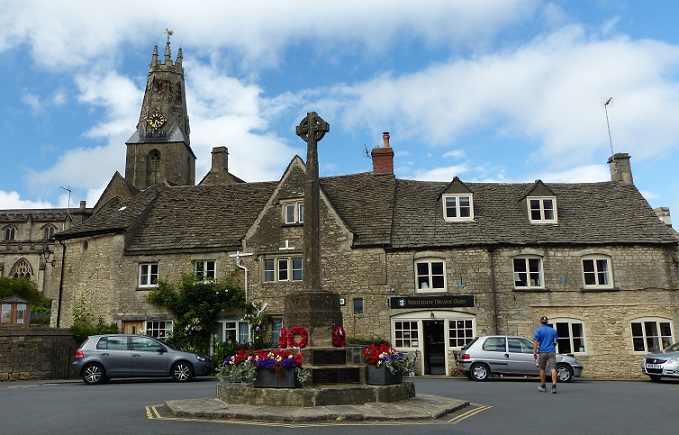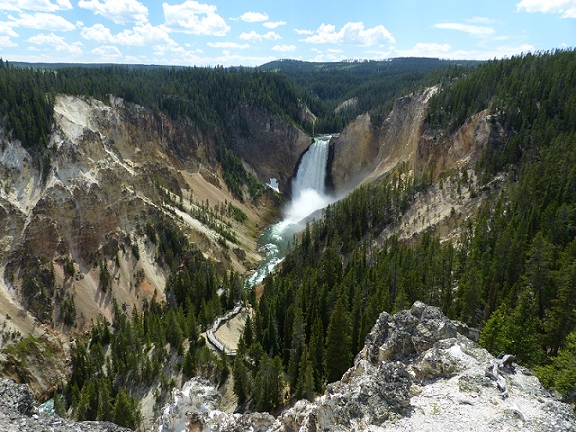
Tregoning
12 April 2024 | We are back aboard Tregoning in Mersin Marina, Mersin, Türkiye
02 April 2024 | We are in Toronto Airport, Canada: Tregoning is in Mersin Marina, Mersin, Türkiye
25 February 2024 | We are back in Gainesville, FL: Tregoning is in Mersin Marina, Mersin, Türkiye
18 February 2024 | We are in Glenwood, New Mexico: Tregoning is in Mersin Marina, Mersin, Türkiye
12 February 2024 | We are in Morro Bay, California: Tregoning is in Mersin Marina, Mersin, Türkiye
19 January 2024 | We are in Vancouver, BC Canada: Tregoning is in Mersin Marina, Mersin, Türkiye
01 January 2024 | We are in Washington State: Tregoning is in Mersin Marina, Mersin, Türkiye
15 December 2023 | We are in Minnesota: Tregoning is in Mersin Marina, Mersin, Türkiye
18 November 2023 | We are in Florida: Tregoning is in Mersin Marina, Mersin, Türkiye
29 October 2023 | We're in Florida - Tregoning is at B-dock, Mersin Marina, Mersin, Türkiye
21 October 2023 | 7 Oda Kapadokya Cave Hotel, Ürgüp, Türkiye
14 October 2023 | Hotel Aşikoğlu, Boğazkale, Türkiye
07 October 2023 | B-dock, Mersin Marina, Mersin, Türkiye
19 September 2023 | “Chez Jon & Angela”, Near Otterton, Devon, UK
14 September 2023 | Airbnb in Fortuneswell on the Isle of Portland, Dorset, UK
11 September 2023 | With Mike, Grange-over-Sands, Cumbria, UK
03 September 2023 | Ardington House, Ardington, Oxfordshire, UK
24 August 2023 | Near "Chez Joan and Peter", College of Roseisle, Moray, Scotland
11 August 2023 | Andrew's house (not exactly), Lichfield, UK
22 July 2023 | Chez Gail, near the New York Café, Budapest, Hungary
Atherton Tablelands and cassowary search
30 September 2020 | Atherton Hotel, Atherton, QLD, Australia
Alison Stocker | Photo: Not the wildest habitat but a wild cassowary nonetheless at Etty Beach
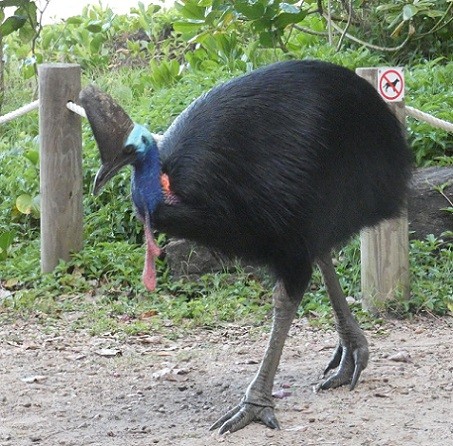
Leaving Daintree Village on Monday morning (28th October) after bidding farewell to Sauce, we were finished with the organized part of our birding tours. This did not mean that we were no longer looking at birds. We still had hopes of finding a wild cassowary but the most likely places for that, at Mission Beach or Etty Bay, would be on the final leg of our trip as we returned to Cairns. In the meantime, there were plenty of other geological and biological sights to see.
We retraced our route back to Mossman, then up the steep road onto the Tablelands, and waved as we drove past Kingfisher Park. We turned south on the Mulligan Highway, passing through Mount Molloy and then we were into new territory for us. We debated about stopping at the Mareeba Wetlands but turned around when we saw that the dirt road was rough in places. Passing through Mareeba and Atherton, we turned left onto Gillies Highway but turned off it just before reaching Yungaburra.
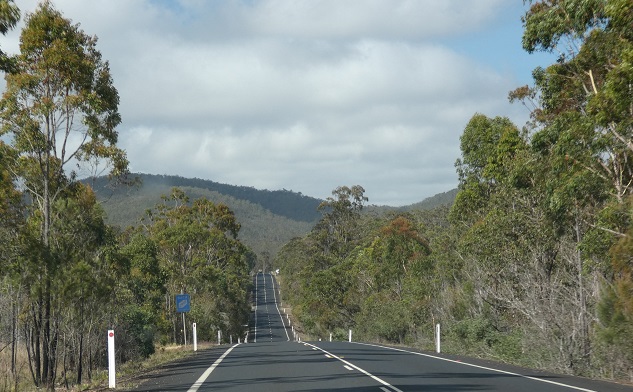
Driving through dry eucalypt forest in the Atherton Tablelands
Our first target was well-signposted and we joined half-a-dozen cars in the car park from which led a short boardwalk into the woods. We did not have to go far to find the local attraction, the curtain fig tree.
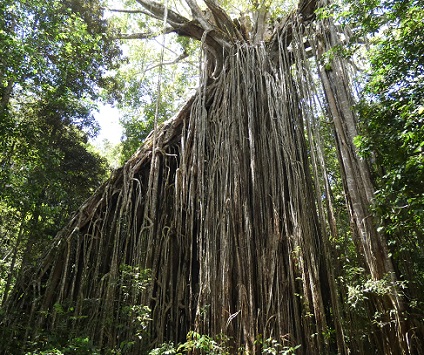
The curtain fig-tree - I realized too late that the picture would have been better with a person for scale - it is big!
Over the years, we have seen plenty of strangler figs that have weaved interesting lattices up their host trees. This was quite different as it did, indeed, form an impressive curtain of vertical fig roots. Fortunately, there was a sign to explain that the fig seed germinated in the crown of the host tree and would have sent roots down to the soil. The unique aspect here was that the host tree started to fall over but was caught in the canopy of a neighboring tree, leaving it leaning at a 45 degree angle. The fig roots continued to grow downward but now created the curtain from the leaning trunk. The host tree eventually rotted away and the free-standing fig tree is supported by its curtain of woody roots and continues to produce branches and leaves in its canopy.
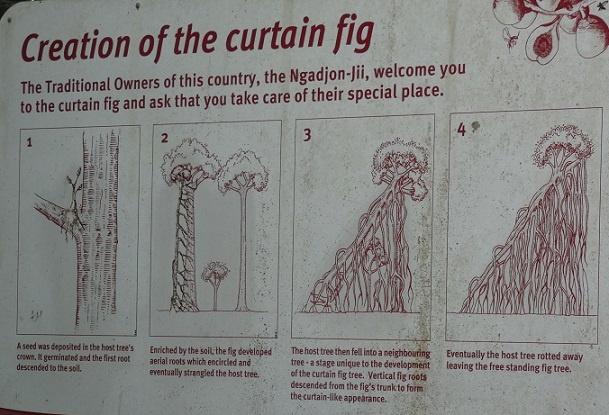
Diagram showing how the curtain fig formed
I am not sure that my pictures do justice to this phenomenon. We were both quite a bit more impressed with this oddity than we had expected to be. Which was a bit more than could be said for our next destination, Malanda Falls. This cascade was pleasant and was a popular place for a swim but the road-bridge just above the falls and the large concrete-lined swimming pool below, rather detracted from the natural beauty of the site.
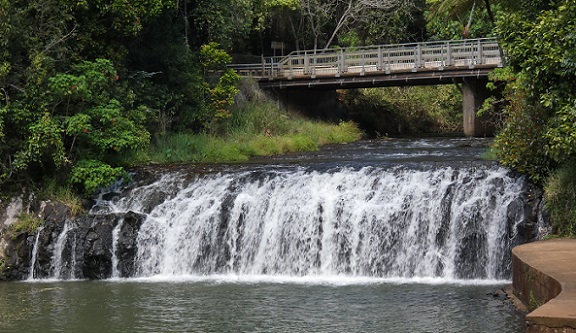
Malanda Falls
However, it was a pleasant place to have our picnic lunch (including the over-sugared cookies) and there was an excellent Visitor Center for the Malanda Falls Conservation Park. Here we were greeted by a marvelously enthusiastic docent who very much encouraged us to look for tree kangaroos. We had seen such creatures in the Sydney Zoo but those animals were from New Guinea and I had dismissed them as not occurring in Australia.
Well, I was wrong as Bennett's tree kangaroos occur in the rainforest around the Daintree River and north to Cooktown (a pretty small area) and Lumholtz's tree kangaroos are distributed south of the Daintree River to Ingham (north of Townsville). The Wet Tropics of Australia and New Guinea are the only places in the world where the 12 to 17 species (the vagueness reflects their secretive habits and remote habitats) of tree kangaroo can be found. As the name implies, these kangaroos spend most of their lives in trees where they look and behave somewhat like koalas with long tails. They can travel on the ground and do hop, like other kangaroos. The docent kindly showed us a video shot by a visitor on one of the local hikes, where two tree kangaroos briefly came bouncing towards them along the trail. We now had a new mission for the day - to see a tree kangaroo.
To this end we crossed the road to take the Rainforest Walk loop trail (where the visitor's video had been made). We did not have any luck with the tree kangaroos but we did managed to see a pair of eastern whipbirds. Easy to recognize by their whip-crack call, they are notoriously difficult to see so it was very satisfying to get a good sighting of them kicking through the leaf litter. We also had good views of a pair of grey-headed robins, including one of them sitting on the nest.
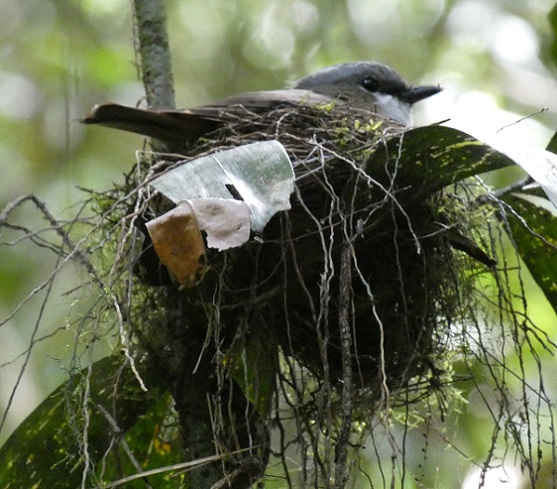
Grey-headed robin (to 18 cm or 7 inches) on a nest
From the Turtle Viewing Platform, we did indeed see several turtles in the North Johnstone River. These were saw-shelled turtles which reminded us of the freshwater snapping turtles found in Florida. Although, saw-shelled turtles have to come to the surface to breathe periodically, they can stay underwater for longer than most turtles because they can exchange some gases through their skin. This is particularly effective in their blood-vessel-rich, ciliated cloaca...or anus. Water is circulated in and out of their cloaca, where gas exchange occurs with the blood, much like the gills of a fish. A turtle that breathes through its "bottom" is a subject of great amusement for children of a certain age!
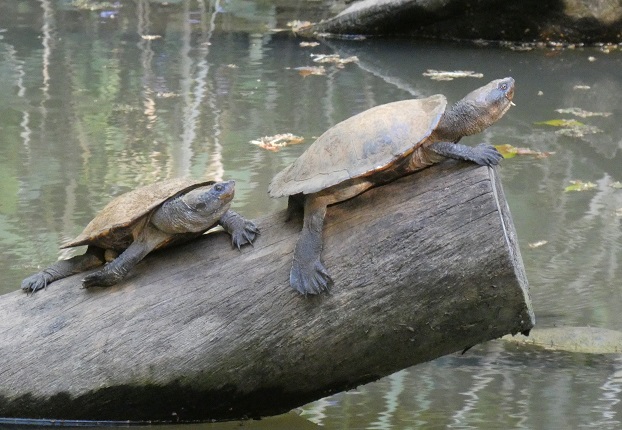
Saw-shelled turtles
Our quest for the tree kangaroo was not over. Both the helpful docent and other guests at Kingfisher Park had told us that these elusive marsupials were often seen at the Visitors Center at the Nerada Tea Plantation. I do not like tea and Randall is only an occasional drinker of it, so we had no interest in the tour of the plantation. Still, I was not sure that I had even seen a tea plantation before so it would not be a completely wasted detour if the tree kangaroos were not evident.
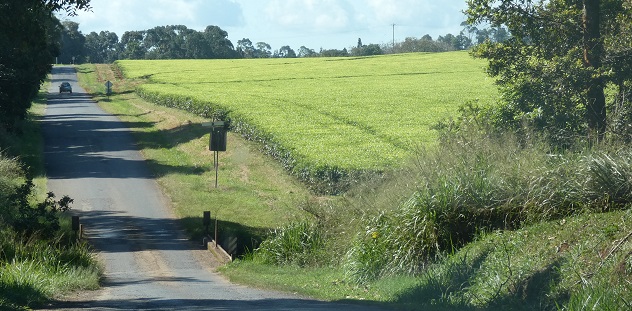
Part of the Nerada Tea Plantation - severely trimmed shrubs provide plenty of young leaves for the tea harvest
Tea plants are members of the camellia family and originated in China. If left untrimmed, they can grow to trees that are 5 to 10 m tall (16 to 33 feet). They take up to seven years to reach the stage at which their leaves can be harvested for tea. Tea harvesting at Nerada was not like that in tea plantations in India and China where people (usually women) walk between the rows plucking the tender young leaves and collecting them in a sack, often worn on their backs. Instead, the tea bushes are grown very densely with widely spaced, narrow lanes for the machinery to pass through, and the shrubs are trimmed for harvest from the top only by machines that were specially designed at Nerada.
Since entrance to the Visitor's Center is free, we felt a little self-conscious about asking where to look for the tree kangaroos with no intention of buying tea or taking a tour. But the staff were obviously used to this question and directed us to the narrow band of eucalyptus trees between the Center and the operational part of the tea mill. As is often the case, after peering into the trees for a few minutes, I realized that it might be better to look for successful viewers than the animals themselves. Until I looked up and saw a distinctive tail hanging down from a fork in the tree.
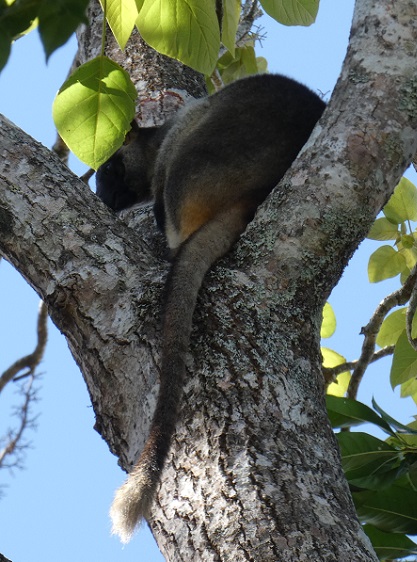
The long tail gave away this Lumholtz's tree kangaroo
We were soon pointing-out this animal to other visitors but then I realized that not everyone was pointing at the same creature. Just a few trees away, another tree kangaroos was sleeping with its face conveniently turned towards us rather than its hind-quarters.
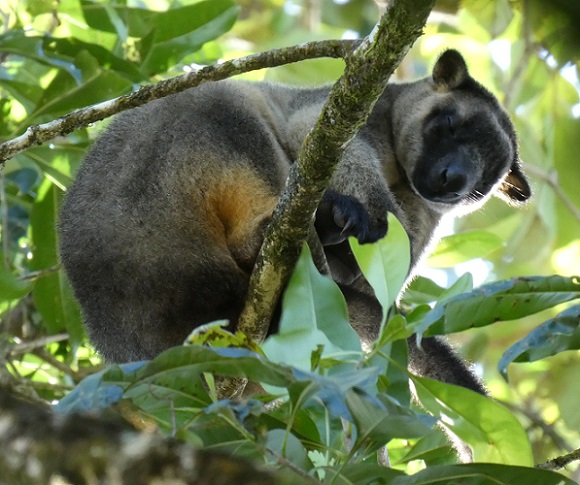
A second tree kangaroo taking a nap
We did not need to watch for long before this animal woke-up and started grooming. This gave us a good view of one of its hind-feet, well-padded for hopping on the ground, as well as a front paw with substantial claws, as needed for tree-climbing. We were thrilled as this was a far better viewing of these arboreal marsupials than we had dared anticipate.
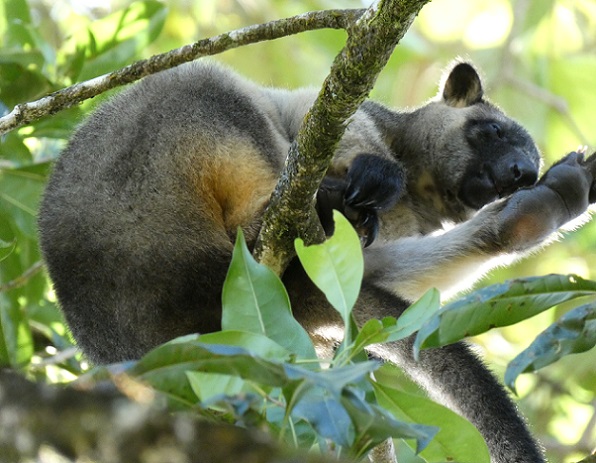
This tree kangaroo started to groom itself
It is a little surprising that there are often tree kangaroos in this not very large area of isolated eucalyptus trees which were only planted in 1991. But there is now a small resident population of tree kangaroos (typically five individuals), and they have been seen there regularly since 1994.
https://www.neradatea.com.au/social-responsibility/tree-kangaroos We were very pleased that we had been able to see them, and in my gratitude to the Tea Plantation Visitor Center, I bought a tea-towel adorned with pictures of the Tea Plantation and a tree kangaroo.
Having detoured to visit Nerada a little further south than we had intended, we made our way back towards Yungaburra. On the way, we stopped at Lake Eacham, one of two crater lakes in the area, the other being Lake Barrine. As is typical of lakes formed in a volcanic crater, Eacham is more or less circular, quite deep, and lacks any in-, or out-flowing streams. The water was clear and it was a popular place for a swim on this hot day. We resisted this temptation, mainly because we had one more objective for the day. Randall was also a little concerned by the sign that explained that a single freshwater crocodile had been released into Lake Eacham. The sign continued, "Unlike estuarine crocodiles, freshwater crocodiles are considered timid and not life-threatening. Very few incidents have been reported involving people. This crocodile may become aggressive and cause injury if disturbed." Not hugely reassuring...
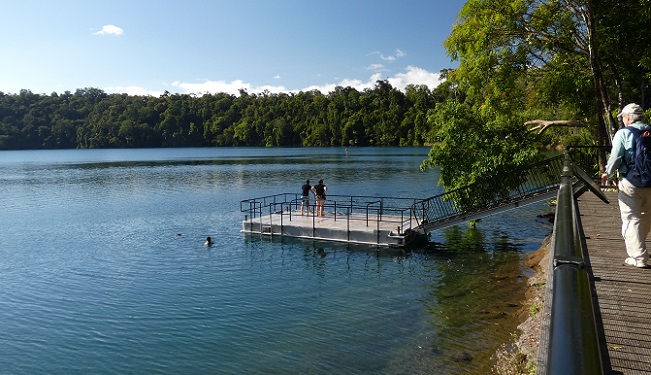
Randall looking over Lake Eacham
Having completed our short loop walk by the lake, we continued into the town of Yungaburra. Established in 1890, this "historic heart of the Atherton Tablelands" has 18 heritage-listed buildings and "its lovely streetscapes (are) largely unchanged from those early pioneer days." The plastic wheelie-bins on the side of the road, awaiting garbage pick-up, would be one of the more noticeable changes, but we understood the general intent of the hyperbole in our Visitor's Guide to the Atherton Tablelands.
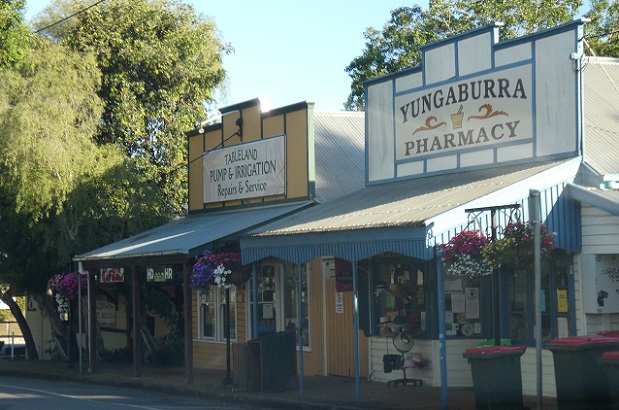
Shop-fronts typical of the picturesque part of Yungaburra
Cute stores were not our reason for stopping in this town, however. We had been attracted by the description of the town's "focal attraction...the Peterson Creek Walking Circuit where there are nearly always platypus to be spotted." How could we resist?
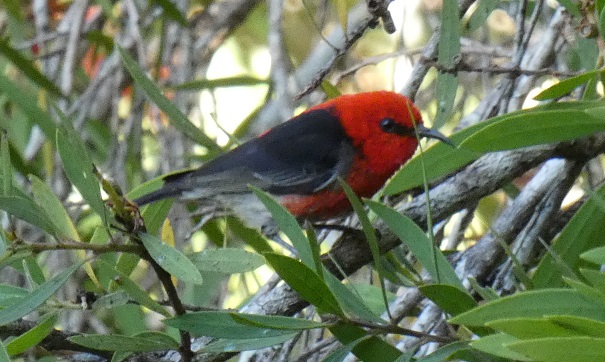
A male scarlet myzomela (a.k.a. scarlet honeyeater - to 14 cm or 5.5. inches)
It was getting to be late in the afternoon, which seemed like a good time for platypus activity, so we joined the trail and started walking towards the "Platypus viewing platform". A small flock of male and female scarlet myzomelas feeding in a bottlebrush tree with scarlet flowers distracted us briefly, but we were soon peering intently at the muddy water of Peterson Creek. Periodically, a few unexplained ripples caused us to pause and watch for a few minutes but we gradually kept walking downstream towards the platform.
Mindful of our earlier thoughts on what to look for, we stopped as soon as we came across a quiet group of people watching the water. A whispered enquiry revealed that they had, indeed, seen a platypus there, so we started our own vigil on the riverbank noting a few small bubbles emerging but no ripples on the water surface. I then heard Randall give a subdued "Fox family" whistle and I crept over to where he was staring at his feet. Sure enough, a brown head and brown duck-bill was rummaging around in the grasses overhanging the water from which semicircles of ripples were emanating.
Although it was difficult to see clearly in the grass, it was without doubt a platypus. But it was to get better, as the platypus emerged from the grass and swam a few meters upstream at the water's surface, providing everyone assembled with an excellent view. I even managed to have the presence of mind to capture a few seconds of its rapid doggie-paddle swimming on video.
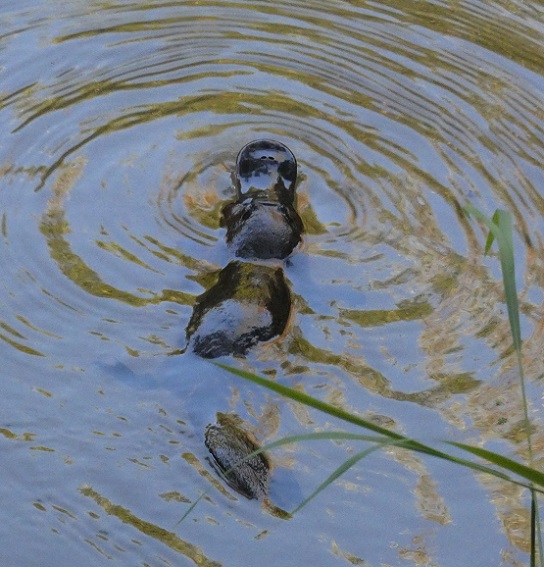
The duck-billed platypus starts to swim away from the shore
Having only seen one of these egg-laying monotremes in a zoo, we were thrilled to see one, finally, in the wild. We were still a little surprised at how small they are, only reaching 50 cm or 20 inches in length, including the relatively large duck-bill and even longer paddle-shaped tail. If there had been no one else present, we would have probably lingered for longer to watch this animal that seemed uncharacteristically undisturbed by our presence. Perhaps with this popular walk and the viewing platform nearby, these particular animals have become habituated to humans. With more people arriving, we decided to get out of their way and to cherish our own brief viewing.
Starting with our Daintree River bird tour, it had been a long productive day, so we headed back to our overnight lodging at the Atherton Hotel. It was a little strange to have a large room with only a couple of skylights but no window, but it was comfortable and quiet. After a tasty Thai dinner down the street, and a rare opportunity to watch TV and catch-up with world news, we went to sleep early, having planned to leave Atherton by 6:30 am.
Why another early start?
Birds, of course!
Not an organized bird-tour but we drove a little west of the town and followed signs for the Nyleta Wetland, Hasties Swamp National Park. Part of the traditional lands of the Yidinji Aboriginal people, this area was named Nyleta, meaning "Where the waters meet". Many wetlands on the Atherton Tablelands were drained for agricultural uses but Nyleta was preserved as an important stock reserve, providing water and feed for traveling herds of cattle and bullock teams. Growing recognition of this wetland as an important bird habitat resulted in the creation of the small (57 ha or 142 acre) National Park in 1980. Although a seasonal wetland that can dry-out during particularly dry year, a low weir at the main outflow of the lagoon, helps to maintain water levels to offset the effects of development in the wetland's catchment area.
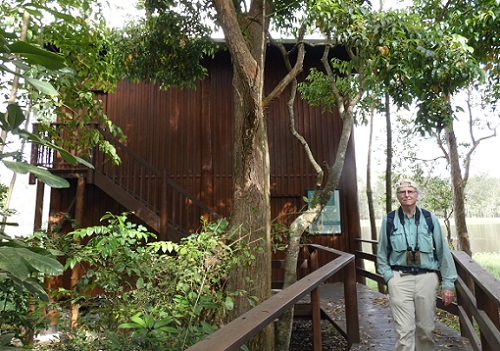
Randall outside the two-floor bird hide at Nyleta Wetland
Part of the attraction of the Park is an impressive two-floor bird hide (bird-blind). The elevation provided by the upper floor, makes a big difference to the view over the lagoon. There had apparently been enough springtime rain to fill the lagoon which was covered with waterfowl.
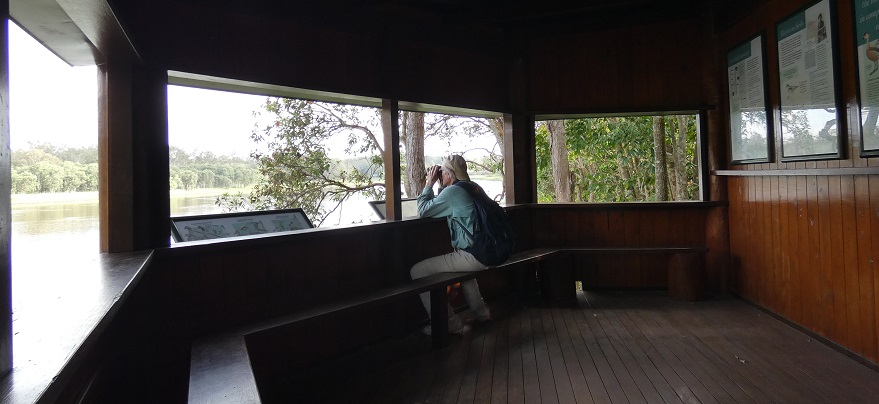
Randall in the top floor of the bird hide
More than 220 bird species have been recorded in this National Park, mostly wetland and open woodland species. We were amazed to see hundreds of ducks in the open water and numerous other species wading around the edges.
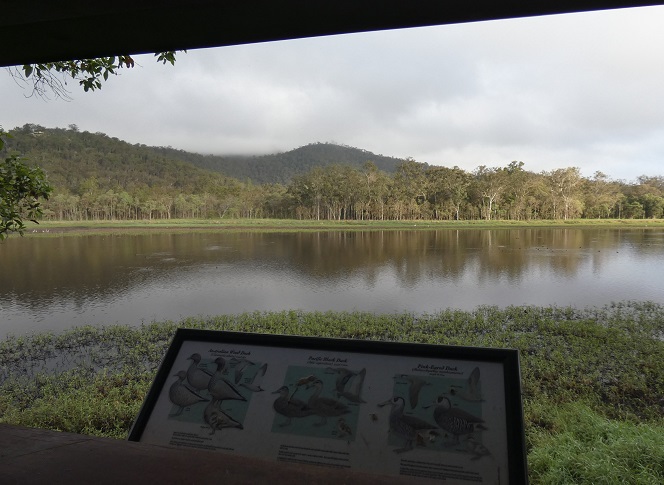
View across the lagoon from the top floor of the bird hide
Most of the ducks were recognizable from the white tip of their bill and the white patch under the tail. These were hardheads, a species we had seen before but never in these numbers.

Male hardheads with white eyes, females have dark eyes
There were also many Pacific black ducks in the mix (similar to female mallards but with dark eye stripes) and a few Australian grey teal. Smaller than the ducks and with a more upright posture, a few Australasian grebes moved busily across the water, while intermediate egrets, purple swamphens, dusky moorhens, Eurasian coots, and even a comb-crested jacana, prowled the weeds around the lagoon's edge. It was exactly the multitude of wetland birds that we had been hoping to see and we spent an animated hour and a half, counting the various species for Randall's e-bird survey.
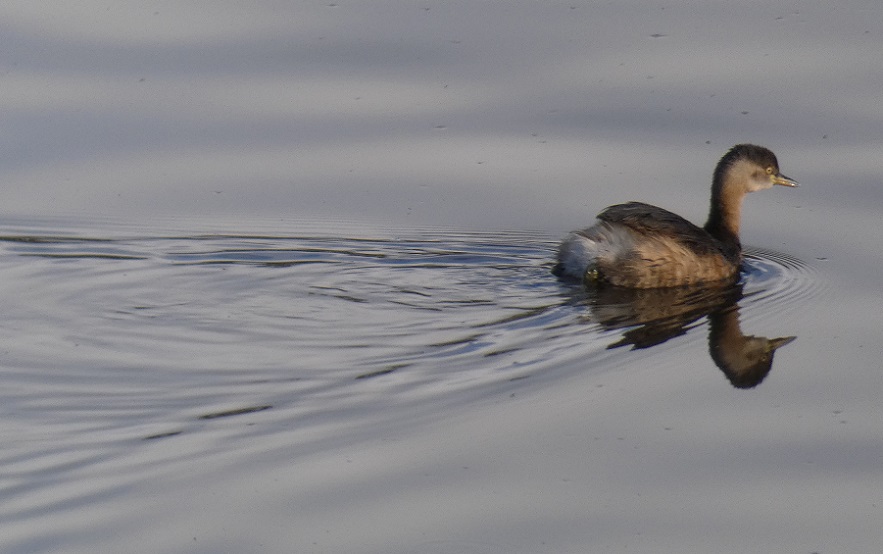
An Australasian grebe paddles across the glassy water surface
The most exciting birds for us were on the other side of the lagoon from the hide, but their size made them easy to see. We had hoped to see the relatively common brolga cranes, as they are often found in the wetland. After studying the eight tall grey birds with red heads and necks, we were exhilarated to realize that they were the similar, but much rarer, sarus cranes (LL or life-list species). Their distribution in Australia is limited to just a few areas in the north including most of Cape York north of Townsville.
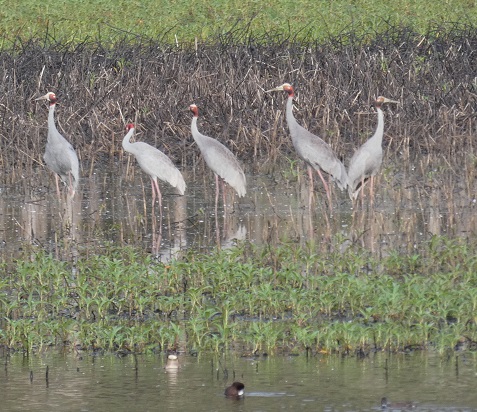
Five of the adult sarus cranes (to 115 cm with 240 wingspan or 45 and 94 inches)
Most of the group were adults with the distinctive red heads but two were immature with tan colored heads. As we watched, some of the mature birds took flight and circled the wetland several times. It felt as though we were back in Florida watching sandhill cranes take off from Paynes Prairie.
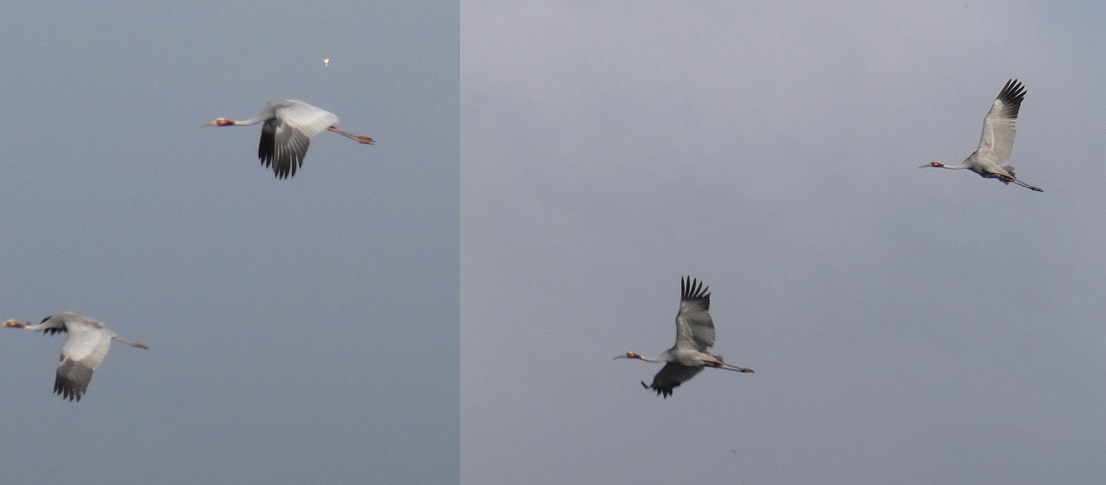
Two pairs of sarus cranes in flight over Nyleta Wetland
Realizing that it was not even 9 am by the time we left Nyleta, we decided to extend our area of exploration before we headed back towards the coast. Thus, we drove through Herberton, the oldest town on the Atherton Tablelands, before turning southeast towards Millaa Millaa. We did not feel inspired to wait for the opening of the Herberton Historic Village with its 60 restored buildings arranged to resemble a mining town from the 1880s, but we could see that it looked very well-maintained as we drove past.
After passing through Millaa Millaa we turned off the Palmerston Highway to take the Waterfalls Circuit. The first stop was at the narrow delicate cascade of Millaa Millaa Falls which are 18.3 m tall (60 feet). The falls are named after one of the rainforest vines in the language of the MaMu Aboriginal People who were the Traditional Owners of this area. The car park was quite busy but nobody seemed to be taking advantage of the opportunity to swim in the rather murky water. Maybe it would be more appealing later in the day.
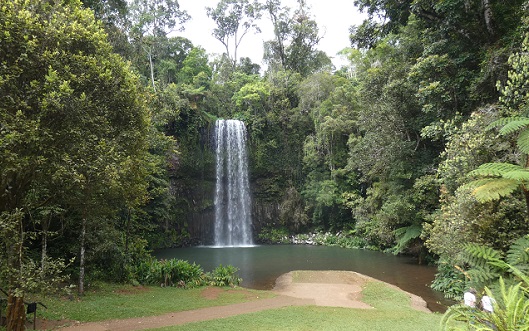
Millaa Millaa Falls
As we continued around the loop road to Zillie Falls, we noticed that the countryside looked very much like the North Island of New Zealand, or even the UK. This reinforced the impression that we had gained from a panoramic vista that we had visited just prior to reaching the small town of Millaa Millaa. Looking east from the edge of the Atherton Plateau, the scattering of trees and pastures had looked quite different from the rainforest, dry sclerophyll forests, red-soil outback, or anything else we had seen in Australia. Of course, a closer look at the trees soon put us back in the land of eucalyptus and hoop pines, as did the birds. The latter include a Pacific Baza (LL, a.k.a. crested hawk) which flew across the road in front of us and landed in a tree where we could conveniently see the distinguishing crest on the back if its head.
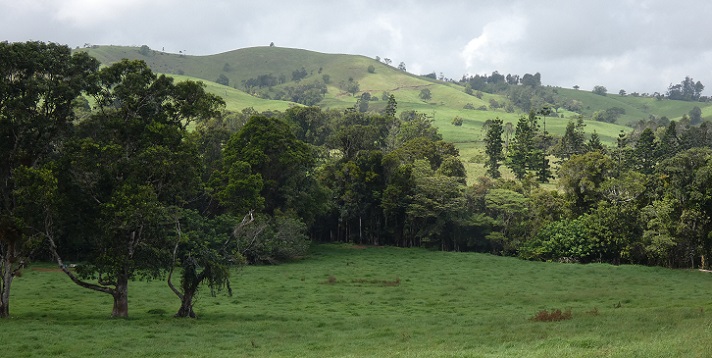
The New Zealand- or British-like pastoral scene between Millaa Millaa and Zillie Falls
The trail to the bottom of Zillie Falls and back up was a little rough and strenuous but it was the only way to see the whole of the cascade. The surroundings were not manicured as they had been at Millaa Millaa Falls but were quite unspoiled. The Atherton Tablelands were the result of several periods of volcanic activity, the most recent eruptions between 4 and 1 million years ago. The many waterfalls in the region, including Australia's tallest waterfall (Wallaman Falls) and widest single-drop waterfall (Millstream Falls), have formed on streams that have eroded columnar basalt upstream until a particularly resistant horizontal layer of basalt has halted the erosion. This durable horizontal layer was particularly obvious at Zillie Falls.
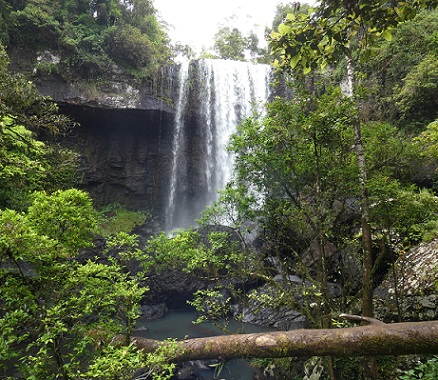
Zillie Falls
Continuing the loop road, we passed a farmhouse that was screened from the road by a tall hedge that was absolutely covered in flowers. The purple and white flowers indicated that it was a yesterday-today-and-tomorrow plant (endemic to Brazil and a toxic member of the Solanaceae). These flowers last for three days, changing color each day. They are initially purple, then turn lavender, then white, with all three colors displayed on a blooming plant. We were not sure that we had ever seen such a high density of flowers on a hedge.
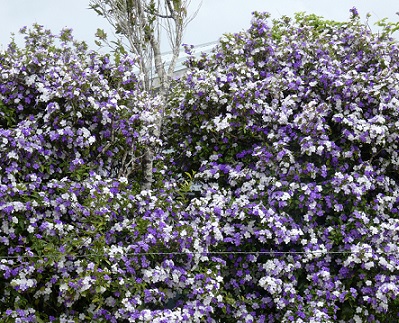
Part of the densely bloomed hedge of yesterday-today-and-tomorrow plants
Despite warnings that the path was very steep, the paved trail to the base of Ellinjaa Falls was quite easy compared to the rocky trail at Zillie Falls. This was the most delicate of the cascades with a less well-defined edge and drop compared to Millaa Millaa and Zillie Falls. A sign suggested that platypus may be seen in the early morning and late afternoon but, being midday, we hardly bothered to look.
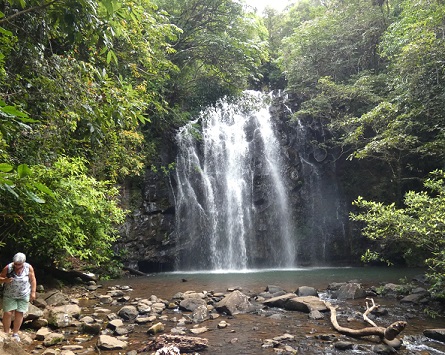
Ellinjaa Falls
Having completed the Waterfalls Circuit, we took the Palmerston Highway to Innisfail on the Bruce Highway (which connects Cairns and Brisbane). Descending from the plateau, our route passed through the rainforest of Wooroonooran National Park before flattening out on the coastal plain. Instead of turning north to return to Cairns, we went south to El Arish where we turned-off for Mission Beach. Before reaching the coast, however, we resumed our search for cassowaries by walking the Lacey Creek loop trail in the rainforest of Djiru National Park. It was a pleasant walk but, as before, we saw plenty of old cassowary scat but no recent signs of their presence.
Continuing to Mission Beach, we soon realized that this was a much longer beach and busier resort town than we had imagined, so our hopes of finding a cassowary there were starting to fade. We walked briefly on the beach but decided our best option was to get some local knowledge at the Visitor Information Center. A very friendly volunteer understood our mission and suggested that if the other short trail in the Djiru National Park did not prove productive, our best option was to go to Etty Bay (near Innisfail) where there are resident birds that are more likely to be visible.
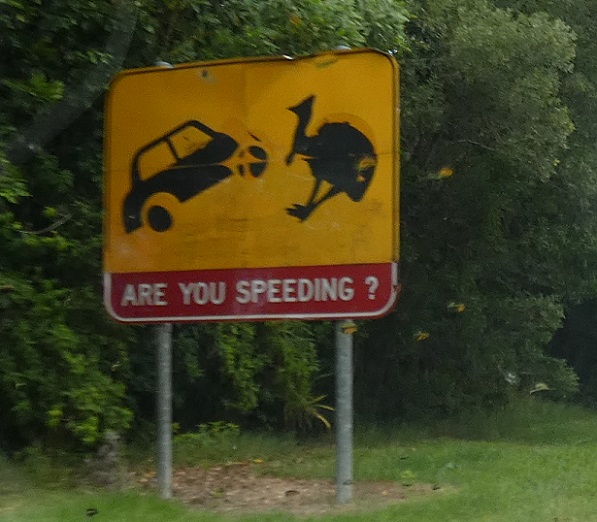
In the area around Mission Beach, there were many signs referring to cassowaries
As suggested we did stop and walk on another National Park trail at Licuala but with no success. It started to rain heavily while we were on the Fan Palm loop trail. At first, we sheltered under some of the fan palms but once it was apparent that the rain was persisting for longer than the fans could keep us dry, we had to run back to the car.
Since Etty Bay was on the way back to Cairns, one might think that we would have returned to the Bruce Highway and hurried north. Instead we turned south for just a few more miles to make a brief visit to the agricultural town of Tully, in part to see the famous "Golden Gumboot". The height of the gumboot is 7.9 m (25.9 feet) and represents the amount of rainfall recorded in Tully in 1950, an Australian record. That is quite a bit of rain.
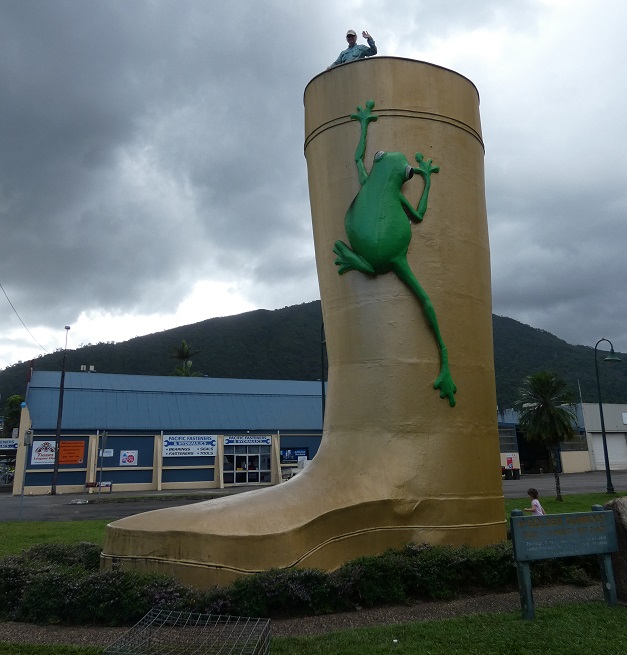
Randall waving from the top of the Golden Gumboot
Tully's average annual rainfall is 4.49 m (14.7 feet) and the town gets so much rain because it is in the wet tropics where cyclones and monsoon conditions can develop at certain times of year. Particularly in January through April, clouds that form as the winds blow in from the ocean have to rise over the mountain range on the seaward edge of the Atherton Tablelands. While rising, these clouds drop rain on the narrow strip of coastal plain where Tully is located. Originally a rubber boot was awarded to the Australian town with the highest rainfall in the preceding year and Tully, Innisfail, and Babinda (between Innisfail and Cairns) used to vie for the prize. By 1997, the citizens of Tully decided that they really deserved a permanent award and so conceived the idea of the huge Golden Gumboot with a staircase inside.
A positive consequence of all the rain is that the coastal plain is a highly productive agricultural area. Many tropical fruits are grown in there but the most obvious plantations are sugarcane and bananas. There is a large cane mill in Tully and, from the top of the Gumboot, we could see a line of many train-cars full of sugarcane waiting to be fed into the presses.
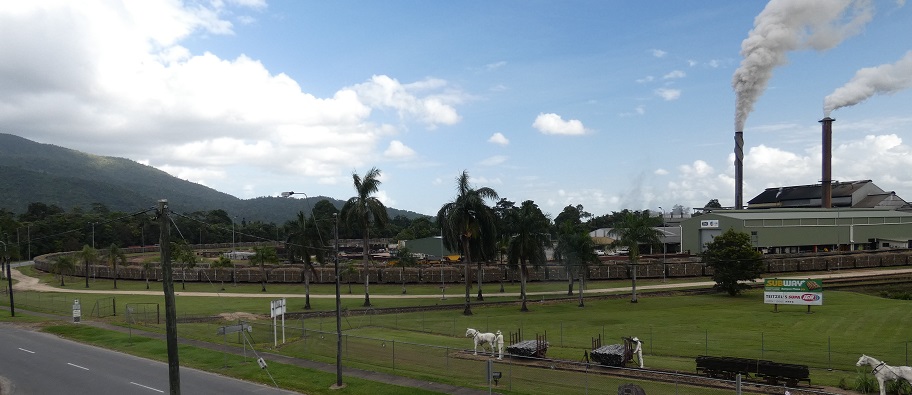
The sugarcane mill in Tully with the curving line of train-cars full of chopped cane
Our other reason for making the detour to visit Tully was because we were curious to see where Josie had lived for five months when she first arrived in Australia. We had not been surprised by the sight of all the banana plantations in the area because we remembered that her job had been to drive a tractor on one. We phoned her in Melbourne from the Gumboot to tell where we were and I think that she was quite tickled that we had made the effort to see the place. She was busy working so we did not chat for long but she did bemoan the lockdown in Victoria that was limiting her ability to travel.
While we were having such a splendid week of exploration and nature appreciation, it had been easy to forget that most of the rest of the world was suffering from the Covid-19 pandemic and associated restrictions on travel and social activities. These effects did not pass us by completely, however. During our stay at Kingfisher Park, I heard from my cousin Sarah in Victoria that her father in the UK was declining rapidly. Her mother had died in April and Sarah had only been able to attend her passing and the funeral online. This seemed so very hard and I knew that she was worried that, despite his severe dementia, her father would miss Gillian very much. I remembered her father, David, as being such an energetic, witty, and friendly person that it was hard for me to imagine him being any other way.
Knowing that she would have to be extremely careful and would have to quarantine at her own expense in a designated hotel on her return, Sarah made the difficult decision to go to the UK, having received a Compassionate Exemption to leave Australia. Sadly, she arrived a day too late as David died on Monday 28th September. Although this was disappointing, Sarah was then able to work with her brother to arrange the cremation and she can sort-out the house and her parents' belongings before returning to Australia in December. She had to book to fly back by business class because economy passengers are likely to be bumped to later flights as Covid-19 restrictions limit the number of passengers on airlines, with priority given to business class. We felt very sorry for Sarah to have such a sad year, but glad that she would be able to see her brother, eldest son, and other family members during the visit.
Coming to the end of our marvelous week's digression from Tregoning and Cairns, we still had one last place to try to see a cassowary, Etty Bay. However, wanting to return to Cairns before dark, we would not have much time to spend searching for the birds so we were pretty resigned that the fresh scat in The Daintree might be the closest we would get to a wild specimen.
But luck was on our side...
Just as we finished the descent into the small community at Etty Bay, I cried-out to Randall to stop because there was a cassowary right by the side of the road. It appeared to be eating a mango (a large mature one that looked likely to have been put there deliberately as the local trees were only just starting to produce small fruit) but by the time we had parked by the beach and collected camera, binoculars, etc., the large bird had decided to take a walk.
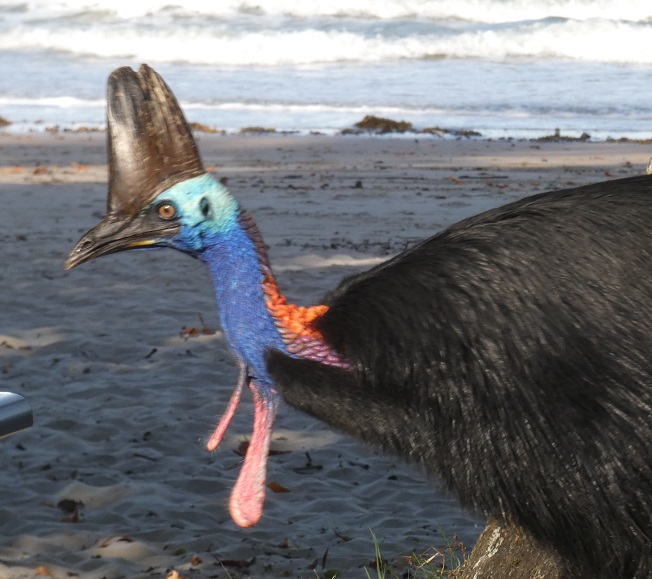
The colorful head and neck of a mature cassowary with its large horn-like casque that is used to crash through vines and other vegetation if disturbed
After seeing all the signs warning about what to do if a cassowary approaches you, we were a bit wary of getting too close to a bird that has a vicious kick with lethal claws. This particular bird was probably very used to people and more or less ignored us and the other half-dozen new arrivals with our cameras at the ready.
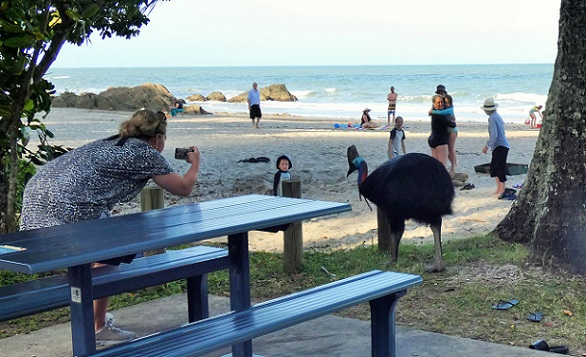
Walking along the top of Etty beach, the cassowary attracts attention for new arrivals like us but was ignored by many people on the beach who were used to seeing them
After a brief stroll along the beach, the cassowary turned inland, crossed the road and proceeded to walk through the middle of a very densely packed campground. It was quite extraordinary to see this large creature delicately pick its way between camper vans and trucks, and over tent guy-ropes.
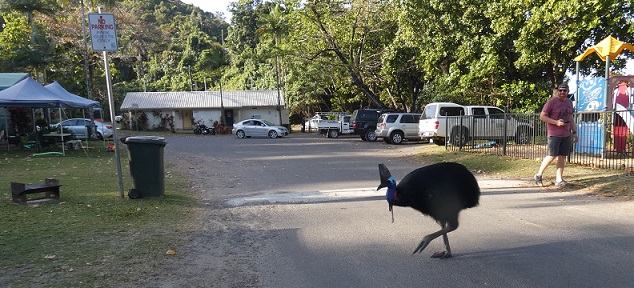
The cassowary crossed the road from the beach into the busy campground
As at beach, most of the people in the campground were sufficiently used to the cassowary not to pay much attention to its presence. We soon realized that this was probably a frequent route for the bird when it finally stopped in a narrow alley between two houses. Here it stayed for a while to drink water from a pair of buckets. Lowering its head to slurp then raising it to swallow, reminded us of one of those glass birds with red fluid in a bulb that automatically dips its head in and out of a glass of water as the water evaporates from the head.
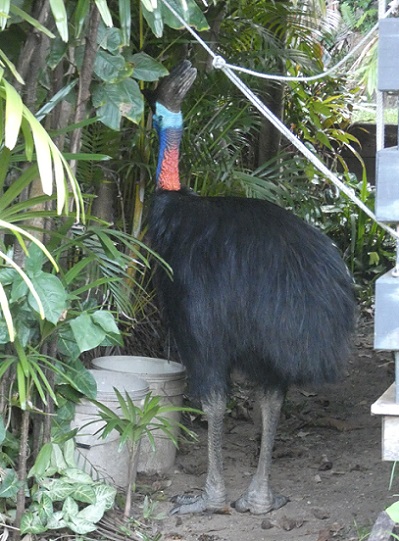
The cassowary stops for a drink of water from the buckets that we presume were deliberately left for it
It was not exactly the wildest of cassowaries and the habitat was hardly natural, but our mission had been accomplished and we could return to Cairns fully satisfied. It had been an extraordinary week of birding, viewing rare marsupials, and enjoying the vegetation and landscapes of a unique part of the continent. We were especially grateful for all of the good advice about places to visit that we had received along the way, particularly from Carol. Feeling thoroughly pleased with our brief tour of the inland Wet Tropics, as soon as we returned to find all well on Tregoning, I started planning how we could get out to explore the local part of the Great Barrier Reef before we had to start sailing south and away from the cyclone belt.
We retraced our route back to Mossman, then up the steep road onto the Tablelands, and waved as we drove past Kingfisher Park. We turned south on the Mulligan Highway, passing through Mount Molloy and then we were into new territory for us. We debated about stopping at the Mareeba Wetlands but turned around when we saw that the dirt road was rough in places. Passing through Mareeba and Atherton, we turned left onto Gillies Highway but turned off it just before reaching Yungaburra.

Driving through dry eucalypt forest in the Atherton Tablelands
Our first target was well-signposted and we joined half-a-dozen cars in the car park from which led a short boardwalk into the woods. We did not have to go far to find the local attraction, the curtain fig tree.

The curtain fig-tree - I realized too late that the picture would have been better with a person for scale - it is big!
Over the years, we have seen plenty of strangler figs that have weaved interesting lattices up their host trees. This was quite different as it did, indeed, form an impressive curtain of vertical fig roots. Fortunately, there was a sign to explain that the fig seed germinated in the crown of the host tree and would have sent roots down to the soil. The unique aspect here was that the host tree started to fall over but was caught in the canopy of a neighboring tree, leaving it leaning at a 45 degree angle. The fig roots continued to grow downward but now created the curtain from the leaning trunk. The host tree eventually rotted away and the free-standing fig tree is supported by its curtain of woody roots and continues to produce branches and leaves in its canopy.

Diagram showing how the curtain fig formed
I am not sure that my pictures do justice to this phenomenon. We were both quite a bit more impressed with this oddity than we had expected to be. Which was a bit more than could be said for our next destination, Malanda Falls. This cascade was pleasant and was a popular place for a swim but the road-bridge just above the falls and the large concrete-lined swimming pool below, rather detracted from the natural beauty of the site.

Malanda Falls
However, it was a pleasant place to have our picnic lunch (including the over-sugared cookies) and there was an excellent Visitor Center for the Malanda Falls Conservation Park. Here we were greeted by a marvelously enthusiastic docent who very much encouraged us to look for tree kangaroos. We had seen such creatures in the Sydney Zoo but those animals were from New Guinea and I had dismissed them as not occurring in Australia.
Well, I was wrong as Bennett's tree kangaroos occur in the rainforest around the Daintree River and north to Cooktown (a pretty small area) and Lumholtz's tree kangaroos are distributed south of the Daintree River to Ingham (north of Townsville). The Wet Tropics of Australia and New Guinea are the only places in the world where the 12 to 17 species (the vagueness reflects their secretive habits and remote habitats) of tree kangaroo can be found. As the name implies, these kangaroos spend most of their lives in trees where they look and behave somewhat like koalas with long tails. They can travel on the ground and do hop, like other kangaroos. The docent kindly showed us a video shot by a visitor on one of the local hikes, where two tree kangaroos briefly came bouncing towards them along the trail. We now had a new mission for the day - to see a tree kangaroo.
To this end we crossed the road to take the Rainforest Walk loop trail (where the visitor's video had been made). We did not have any luck with the tree kangaroos but we did managed to see a pair of eastern whipbirds. Easy to recognize by their whip-crack call, they are notoriously difficult to see so it was very satisfying to get a good sighting of them kicking through the leaf litter. We also had good views of a pair of grey-headed robins, including one of them sitting on the nest.

Grey-headed robin (to 18 cm or 7 inches) on a nest
From the Turtle Viewing Platform, we did indeed see several turtles in the North Johnstone River. These were saw-shelled turtles which reminded us of the freshwater snapping turtles found in Florida. Although, saw-shelled turtles have to come to the surface to breathe periodically, they can stay underwater for longer than most turtles because they can exchange some gases through their skin. This is particularly effective in their blood-vessel-rich, ciliated cloaca...or anus. Water is circulated in and out of their cloaca, where gas exchange occurs with the blood, much like the gills of a fish. A turtle that breathes through its "bottom" is a subject of great amusement for children of a certain age!

Saw-shelled turtles
Our quest for the tree kangaroo was not over. Both the helpful docent and other guests at Kingfisher Park had told us that these elusive marsupials were often seen at the Visitors Center at the Nerada Tea Plantation. I do not like tea and Randall is only an occasional drinker of it, so we had no interest in the tour of the plantation. Still, I was not sure that I had even seen a tea plantation before so it would not be a completely wasted detour if the tree kangaroos were not evident.

Part of the Nerada Tea Plantation - severely trimmed shrubs provide plenty of young leaves for the tea harvest
Tea plants are members of the camellia family and originated in China. If left untrimmed, they can grow to trees that are 5 to 10 m tall (16 to 33 feet). They take up to seven years to reach the stage at which their leaves can be harvested for tea. Tea harvesting at Nerada was not like that in tea plantations in India and China where people (usually women) walk between the rows plucking the tender young leaves and collecting them in a sack, often worn on their backs. Instead, the tea bushes are grown very densely with widely spaced, narrow lanes for the machinery to pass through, and the shrubs are trimmed for harvest from the top only by machines that were specially designed at Nerada.
Since entrance to the Visitor's Center is free, we felt a little self-conscious about asking where to look for the tree kangaroos with no intention of buying tea or taking a tour. But the staff were obviously used to this question and directed us to the narrow band of eucalyptus trees between the Center and the operational part of the tea mill. As is often the case, after peering into the trees for a few minutes, I realized that it might be better to look for successful viewers than the animals themselves. Until I looked up and saw a distinctive tail hanging down from a fork in the tree.

The long tail gave away this Lumholtz's tree kangaroo
We were soon pointing-out this animal to other visitors but then I realized that not everyone was pointing at the same creature. Just a few trees away, another tree kangaroos was sleeping with its face conveniently turned towards us rather than its hind-quarters.

A second tree kangaroo taking a nap
We did not need to watch for long before this animal woke-up and started grooming. This gave us a good view of one of its hind-feet, well-padded for hopping on the ground, as well as a front paw with substantial claws, as needed for tree-climbing. We were thrilled as this was a far better viewing of these arboreal marsupials than we had dared anticipate.

This tree kangaroo started to groom itself
It is a little surprising that there are often tree kangaroos in this not very large area of isolated eucalyptus trees which were only planted in 1991. But there is now a small resident population of tree kangaroos (typically five individuals), and they have been seen there regularly since 1994.
https://www.neradatea.com.au/social-responsibility/tree-kangaroos We were very pleased that we had been able to see them, and in my gratitude to the Tea Plantation Visitor Center, I bought a tea-towel adorned with pictures of the Tea Plantation and a tree kangaroo.
Having detoured to visit Nerada a little further south than we had intended, we made our way back towards Yungaburra. On the way, we stopped at Lake Eacham, one of two crater lakes in the area, the other being Lake Barrine. As is typical of lakes formed in a volcanic crater, Eacham is more or less circular, quite deep, and lacks any in-, or out-flowing streams. The water was clear and it was a popular place for a swim on this hot day. We resisted this temptation, mainly because we had one more objective for the day. Randall was also a little concerned by the sign that explained that a single freshwater crocodile had been released into Lake Eacham. The sign continued, "Unlike estuarine crocodiles, freshwater crocodiles are considered timid and not life-threatening. Very few incidents have been reported involving people. This crocodile may become aggressive and cause injury if disturbed." Not hugely reassuring...

Randall looking over Lake Eacham
Having completed our short loop walk by the lake, we continued into the town of Yungaburra. Established in 1890, this "historic heart of the Atherton Tablelands" has 18 heritage-listed buildings and "its lovely streetscapes (are) largely unchanged from those early pioneer days." The plastic wheelie-bins on the side of the road, awaiting garbage pick-up, would be one of the more noticeable changes, but we understood the general intent of the hyperbole in our Visitor's Guide to the Atherton Tablelands.

Shop-fronts typical of the picturesque part of Yungaburra
Cute stores were not our reason for stopping in this town, however. We had been attracted by the description of the town's "focal attraction...the Peterson Creek Walking Circuit where there are nearly always platypus to be spotted." How could we resist?

A male scarlet myzomela (a.k.a. scarlet honeyeater - to 14 cm or 5.5. inches)
It was getting to be late in the afternoon, which seemed like a good time for platypus activity, so we joined the trail and started walking towards the "Platypus viewing platform". A small flock of male and female scarlet myzomelas feeding in a bottlebrush tree with scarlet flowers distracted us briefly, but we were soon peering intently at the muddy water of Peterson Creek. Periodically, a few unexplained ripples caused us to pause and watch for a few minutes but we gradually kept walking downstream towards the platform.
Mindful of our earlier thoughts on what to look for, we stopped as soon as we came across a quiet group of people watching the water. A whispered enquiry revealed that they had, indeed, seen a platypus there, so we started our own vigil on the riverbank noting a few small bubbles emerging but no ripples on the water surface. I then heard Randall give a subdued "Fox family" whistle and I crept over to where he was staring at his feet. Sure enough, a brown head and brown duck-bill was rummaging around in the grasses overhanging the water from which semicircles of ripples were emanating.
Although it was difficult to see clearly in the grass, it was without doubt a platypus. But it was to get better, as the platypus emerged from the grass and swam a few meters upstream at the water's surface, providing everyone assembled with an excellent view. I even managed to have the presence of mind to capture a few seconds of its rapid doggie-paddle swimming on video.

The duck-billed platypus starts to swim away from the shore
Having only seen one of these egg-laying monotremes in a zoo, we were thrilled to see one, finally, in the wild. We were still a little surprised at how small they are, only reaching 50 cm or 20 inches in length, including the relatively large duck-bill and even longer paddle-shaped tail. If there had been no one else present, we would have probably lingered for longer to watch this animal that seemed uncharacteristically undisturbed by our presence. Perhaps with this popular walk and the viewing platform nearby, these particular animals have become habituated to humans. With more people arriving, we decided to get out of their way and to cherish our own brief viewing.
Starting with our Daintree River bird tour, it had been a long productive day, so we headed back to our overnight lodging at the Atherton Hotel. It was a little strange to have a large room with only a couple of skylights but no window, but it was comfortable and quiet. After a tasty Thai dinner down the street, and a rare opportunity to watch TV and catch-up with world news, we went to sleep early, having planned to leave Atherton by 6:30 am.
Why another early start?
Birds, of course!
Not an organized bird-tour but we drove a little west of the town and followed signs for the Nyleta Wetland, Hasties Swamp National Park. Part of the traditional lands of the Yidinji Aboriginal people, this area was named Nyleta, meaning "Where the waters meet". Many wetlands on the Atherton Tablelands were drained for agricultural uses but Nyleta was preserved as an important stock reserve, providing water and feed for traveling herds of cattle and bullock teams. Growing recognition of this wetland as an important bird habitat resulted in the creation of the small (57 ha or 142 acre) National Park in 1980. Although a seasonal wetland that can dry-out during particularly dry year, a low weir at the main outflow of the lagoon, helps to maintain water levels to offset the effects of development in the wetland's catchment area.

Randall outside the two-floor bird hide at Nyleta Wetland
Part of the attraction of the Park is an impressive two-floor bird hide (bird-blind). The elevation provided by the upper floor, makes a big difference to the view over the lagoon. There had apparently been enough springtime rain to fill the lagoon which was covered with waterfowl.

Randall in the top floor of the bird hide
More than 220 bird species have been recorded in this National Park, mostly wetland and open woodland species. We were amazed to see hundreds of ducks in the open water and numerous other species wading around the edges.

View across the lagoon from the top floor of the bird hide
Most of the ducks were recognizable from the white tip of their bill and the white patch under the tail. These were hardheads, a species we had seen before but never in these numbers.

Male hardheads with white eyes, females have dark eyes
There were also many Pacific black ducks in the mix (similar to female mallards but with dark eye stripes) and a few Australian grey teal. Smaller than the ducks and with a more upright posture, a few Australasian grebes moved busily across the water, while intermediate egrets, purple swamphens, dusky moorhens, Eurasian coots, and even a comb-crested jacana, prowled the weeds around the lagoon's edge. It was exactly the multitude of wetland birds that we had been hoping to see and we spent an animated hour and a half, counting the various species for Randall's e-bird survey.

An Australasian grebe paddles across the glassy water surface
The most exciting birds for us were on the other side of the lagoon from the hide, but their size made them easy to see. We had hoped to see the relatively common brolga cranes, as they are often found in the wetland. After studying the eight tall grey birds with red heads and necks, we were exhilarated to realize that they were the similar, but much rarer, sarus cranes (LL or life-list species). Their distribution in Australia is limited to just a few areas in the north including most of Cape York north of Townsville.

Five of the adult sarus cranes (to 115 cm with 240 wingspan or 45 and 94 inches)
Most of the group were adults with the distinctive red heads but two were immature with tan colored heads. As we watched, some of the mature birds took flight and circled the wetland several times. It felt as though we were back in Florida watching sandhill cranes take off from Paynes Prairie.

Two pairs of sarus cranes in flight over Nyleta Wetland
Realizing that it was not even 9 am by the time we left Nyleta, we decided to extend our area of exploration before we headed back towards the coast. Thus, we drove through Herberton, the oldest town on the Atherton Tablelands, before turning southeast towards Millaa Millaa. We did not feel inspired to wait for the opening of the Herberton Historic Village with its 60 restored buildings arranged to resemble a mining town from the 1880s, but we could see that it looked very well-maintained as we drove past.
After passing through Millaa Millaa we turned off the Palmerston Highway to take the Waterfalls Circuit. The first stop was at the narrow delicate cascade of Millaa Millaa Falls which are 18.3 m tall (60 feet). The falls are named after one of the rainforest vines in the language of the MaMu Aboriginal People who were the Traditional Owners of this area. The car park was quite busy but nobody seemed to be taking advantage of the opportunity to swim in the rather murky water. Maybe it would be more appealing later in the day.

Millaa Millaa Falls
As we continued around the loop road to Zillie Falls, we noticed that the countryside looked very much like the North Island of New Zealand, or even the UK. This reinforced the impression that we had gained from a panoramic vista that we had visited just prior to reaching the small town of Millaa Millaa. Looking east from the edge of the Atherton Plateau, the scattering of trees and pastures had looked quite different from the rainforest, dry sclerophyll forests, red-soil outback, or anything else we had seen in Australia. Of course, a closer look at the trees soon put us back in the land of eucalyptus and hoop pines, as did the birds. The latter include a Pacific Baza (LL, a.k.a. crested hawk) which flew across the road in front of us and landed in a tree where we could conveniently see the distinguishing crest on the back if its head.

The New Zealand- or British-like pastoral scene between Millaa Millaa and Zillie Falls
The trail to the bottom of Zillie Falls and back up was a little rough and strenuous but it was the only way to see the whole of the cascade. The surroundings were not manicured as they had been at Millaa Millaa Falls but were quite unspoiled. The Atherton Tablelands were the result of several periods of volcanic activity, the most recent eruptions between 4 and 1 million years ago. The many waterfalls in the region, including Australia's tallest waterfall (Wallaman Falls) and widest single-drop waterfall (Millstream Falls), have formed on streams that have eroded columnar basalt upstream until a particularly resistant horizontal layer of basalt has halted the erosion. This durable horizontal layer was particularly obvious at Zillie Falls.

Zillie Falls
Continuing the loop road, we passed a farmhouse that was screened from the road by a tall hedge that was absolutely covered in flowers. The purple and white flowers indicated that it was a yesterday-today-and-tomorrow plant (endemic to Brazil and a toxic member of the Solanaceae). These flowers last for three days, changing color each day. They are initially purple, then turn lavender, then white, with all three colors displayed on a blooming plant. We were not sure that we had ever seen such a high density of flowers on a hedge.

Part of the densely bloomed hedge of yesterday-today-and-tomorrow plants
Despite warnings that the path was very steep, the paved trail to the base of Ellinjaa Falls was quite easy compared to the rocky trail at Zillie Falls. This was the most delicate of the cascades with a less well-defined edge and drop compared to Millaa Millaa and Zillie Falls. A sign suggested that platypus may be seen in the early morning and late afternoon but, being midday, we hardly bothered to look.

Ellinjaa Falls
Having completed the Waterfalls Circuit, we took the Palmerston Highway to Innisfail on the Bruce Highway (which connects Cairns and Brisbane). Descending from the plateau, our route passed through the rainforest of Wooroonooran National Park before flattening out on the coastal plain. Instead of turning north to return to Cairns, we went south to El Arish where we turned-off for Mission Beach. Before reaching the coast, however, we resumed our search for cassowaries by walking the Lacey Creek loop trail in the rainforest of Djiru National Park. It was a pleasant walk but, as before, we saw plenty of old cassowary scat but no recent signs of their presence.
Continuing to Mission Beach, we soon realized that this was a much longer beach and busier resort town than we had imagined, so our hopes of finding a cassowary there were starting to fade. We walked briefly on the beach but decided our best option was to get some local knowledge at the Visitor Information Center. A very friendly volunteer understood our mission and suggested that if the other short trail in the Djiru National Park did not prove productive, our best option was to go to Etty Bay (near Innisfail) where there are resident birds that are more likely to be visible.

In the area around Mission Beach, there were many signs referring to cassowaries
As suggested we did stop and walk on another National Park trail at Licuala but with no success. It started to rain heavily while we were on the Fan Palm loop trail. At first, we sheltered under some of the fan palms but once it was apparent that the rain was persisting for longer than the fans could keep us dry, we had to run back to the car.
Since Etty Bay was on the way back to Cairns, one might think that we would have returned to the Bruce Highway and hurried north. Instead we turned south for just a few more miles to make a brief visit to the agricultural town of Tully, in part to see the famous "Golden Gumboot". The height of the gumboot is 7.9 m (25.9 feet) and represents the amount of rainfall recorded in Tully in 1950, an Australian record. That is quite a bit of rain.

Randall waving from the top of the Golden Gumboot
Tully's average annual rainfall is 4.49 m (14.7 feet) and the town gets so much rain because it is in the wet tropics where cyclones and monsoon conditions can develop at certain times of year. Particularly in January through April, clouds that form as the winds blow in from the ocean have to rise over the mountain range on the seaward edge of the Atherton Tablelands. While rising, these clouds drop rain on the narrow strip of coastal plain where Tully is located. Originally a rubber boot was awarded to the Australian town with the highest rainfall in the preceding year and Tully, Innisfail, and Babinda (between Innisfail and Cairns) used to vie for the prize. By 1997, the citizens of Tully decided that they really deserved a permanent award and so conceived the idea of the huge Golden Gumboot with a staircase inside.
A positive consequence of all the rain is that the coastal plain is a highly productive agricultural area. Many tropical fruits are grown in there but the most obvious plantations are sugarcane and bananas. There is a large cane mill in Tully and, from the top of the Gumboot, we could see a line of many train-cars full of sugarcane waiting to be fed into the presses.

The sugarcane mill in Tully with the curving line of train-cars full of chopped cane
Our other reason for making the detour to visit Tully was because we were curious to see where Josie had lived for five months when she first arrived in Australia. We had not been surprised by the sight of all the banana plantations in the area because we remembered that her job had been to drive a tractor on one. We phoned her in Melbourne from the Gumboot to tell where we were and I think that she was quite tickled that we had made the effort to see the place. She was busy working so we did not chat for long but she did bemoan the lockdown in Victoria that was limiting her ability to travel.
While we were having such a splendid week of exploration and nature appreciation, it had been easy to forget that most of the rest of the world was suffering from the Covid-19 pandemic and associated restrictions on travel and social activities. These effects did not pass us by completely, however. During our stay at Kingfisher Park, I heard from my cousin Sarah in Victoria that her father in the UK was declining rapidly. Her mother had died in April and Sarah had only been able to attend her passing and the funeral online. This seemed so very hard and I knew that she was worried that, despite his severe dementia, her father would miss Gillian very much. I remembered her father, David, as being such an energetic, witty, and friendly person that it was hard for me to imagine him being any other way.
Knowing that she would have to be extremely careful and would have to quarantine at her own expense in a designated hotel on her return, Sarah made the difficult decision to go to the UK, having received a Compassionate Exemption to leave Australia. Sadly, she arrived a day too late as David died on Monday 28th September. Although this was disappointing, Sarah was then able to work with her brother to arrange the cremation and she can sort-out the house and her parents' belongings before returning to Australia in December. She had to book to fly back by business class because economy passengers are likely to be bumped to later flights as Covid-19 restrictions limit the number of passengers on airlines, with priority given to business class. We felt very sorry for Sarah to have such a sad year, but glad that she would be able to see her brother, eldest son, and other family members during the visit.
Coming to the end of our marvelous week's digression from Tregoning and Cairns, we still had one last place to try to see a cassowary, Etty Bay. However, wanting to return to Cairns before dark, we would not have much time to spend searching for the birds so we were pretty resigned that the fresh scat in The Daintree might be the closest we would get to a wild specimen.
But luck was on our side...
Just as we finished the descent into the small community at Etty Bay, I cried-out to Randall to stop because there was a cassowary right by the side of the road. It appeared to be eating a mango (a large mature one that looked likely to have been put there deliberately as the local trees were only just starting to produce small fruit) but by the time we had parked by the beach and collected camera, binoculars, etc., the large bird had decided to take a walk.

The colorful head and neck of a mature cassowary with its large horn-like casque that is used to crash through vines and other vegetation if disturbed
After seeing all the signs warning about what to do if a cassowary approaches you, we were a bit wary of getting too close to a bird that has a vicious kick with lethal claws. This particular bird was probably very used to people and more or less ignored us and the other half-dozen new arrivals with our cameras at the ready.

Walking along the top of Etty beach, the cassowary attracts attention for new arrivals like us but was ignored by many people on the beach who were used to seeing them
After a brief stroll along the beach, the cassowary turned inland, crossed the road and proceeded to walk through the middle of a very densely packed campground. It was quite extraordinary to see this large creature delicately pick its way between camper vans and trucks, and over tent guy-ropes.

The cassowary crossed the road from the beach into the busy campground
As at beach, most of the people in the campground were sufficiently used to the cassowary not to pay much attention to its presence. We soon realized that this was probably a frequent route for the bird when it finally stopped in a narrow alley between two houses. Here it stayed for a while to drink water from a pair of buckets. Lowering its head to slurp then raising it to swallow, reminded us of one of those glass birds with red fluid in a bulb that automatically dips its head in and out of a glass of water as the water evaporates from the head.

The cassowary stops for a drink of water from the buckets that we presume were deliberately left for it
It was not exactly the wildest of cassowaries and the habitat was hardly natural, but our mission had been accomplished and we could return to Cairns fully satisfied. It had been an extraordinary week of birding, viewing rare marsupials, and enjoying the vegetation and landscapes of a unique part of the continent. We were especially grateful for all of the good advice about places to visit that we had received along the way, particularly from Carol. Feeling thoroughly pleased with our brief tour of the inland Wet Tropics, as soon as we returned to find all well on Tregoning, I started planning how we could get out to explore the local part of the Great Barrier Reef before we had to start sailing south and away from the cyclone belt.
Comments
| Vessel Name: | Tregoning |
| Vessel Make/Model: | Morgan Classic 41 |
| Hailing Port: | Gainesville, FL |
| Crew: | Alison and Randall |
| About: | We cast-off from Fernandina Beach in north Florida on 1st June 2008 and we have been cruising on Tregoning ever since. Before buying Tregoning, both of us had been sailing on smaller boats for many years and had worked around boats and water throughout our careers. |
| Extra: | “Tregoning” (rhymes with “belonging”) and is a Cornish word (meaning “homestead of Cohnan” or “farm by the ash trees”) and was Alison's mother’s middle name. Cornwall is in southwest England and is where Alison grew-up. |
Tregoning's Photos - Main
 |
Extra photographs from our three-week campervan tour of the South Island from November 15th to December 5th 2015
217 Photos
Created 4 January 2016
|
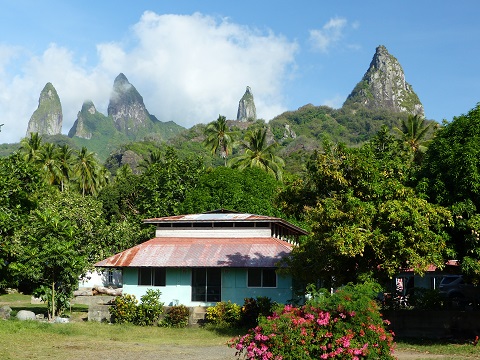 |
Random pictures from our month spent on the islands of Hiva Oa, Tahuata, Ua Pou, and Nuku Hiva
45 Photos
Created 18 July 2015
|
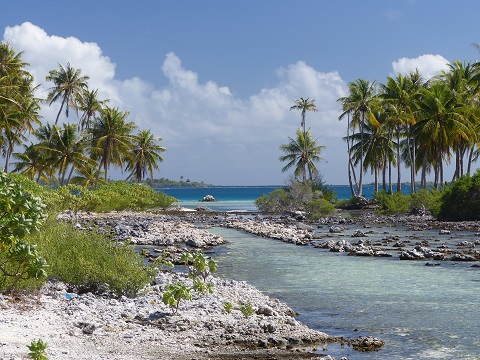 |
Random pictures from our month spent in 4 Tuamotu Atolls; Ahe, Fakarava, Tahanea, and Toau
32 Photos
Created 1 July 2015
|
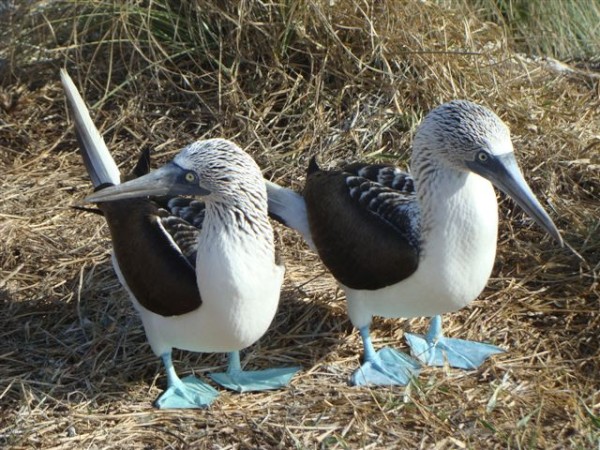 |
Some of the birds, fish, reptiles, and mammals (and others) that we have seen in Mexico
74 Photos
Created 5 May 2014
|
Tregoning

Who: Alison and Randall
Port: Gainesville, FL
